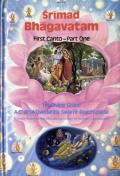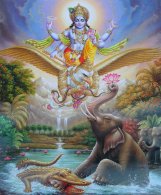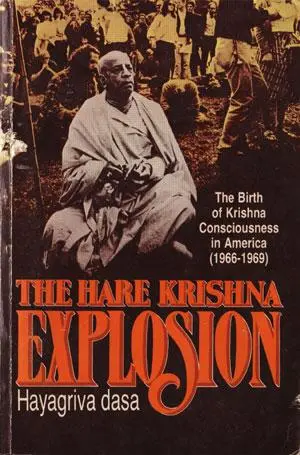Today marks the festival of Dipavali. Dipavali [Diwali} Sunday, October 30, 2016 [Mayapura, West Bengal, India time]. The Dīpāvalī festival takes place on the dark-moon night in the month of Kārttika (October-November).
Diwali or Deepavali is the Hindu festival of lights celebrated every year in autumn in the northern hemisphere (spring in southern hemisphere) is one of the major festivals of Hinduism. It spiritually signifies the victory of light over darkness, good over evil, knowledge over ignorance, and hope over despair. Its celebration includes millions of lights shining on housetops, outside doors and windows, around temples and other buildings in the communities and countries where it is observed. The festival preparations and rituals typically extend over a five-day period, but the main festival night of Diwali coincides with the darkest, new moon night of the Hindu Lunisolar month Kartika in Bikram Sambat calendar. (excerpted from Wikipedia)
Although we do not celebrate in typical Hindu fashion, we do honor Dipavli as Srila Prabhupada has explained that the actual meaning of Dipavali celebration is Lord Krsna breaking the pot of yogurt and being bound by Yasodamayi.
Srila Prabhupada Explains Dipavali (Diwali)
…Śrīla Viśvanātha Cakravartī Ṭhākura, quoting from the Vaiṣṇava-toṣaṇī of Śrīla Sanātana Gosvāmī, says that the incident of Kṛṣṇa’s breaking the pot of yogurt and being bound by mother Yaśodā took place on the Dipavali Day, or Dīpa-mālikā. Even today in India, this festival is generally celebrated very gorgeously in the month of Kārtika by fireworks and lights, especially in Bombay. It is to be understood that among all the cows of Nanda Mahārāja, several of mother Yaśodā’s cows ate only grasses so flavorful that the grasses would automatically flavor the milk. Mother Yaśodā wanted to collect the milk from these cows, make it into yogurt and churn it into butter personally, since she thought that this child Kṛṣṇa was going to the houses of neighborhood gopas and gopīs to steal butter because He did not like the milk and yogurt ordinarily prepared. (from purport to SB 10.9.1-2)
Full text and Purport
Śrīmad-Bhāgavatam: Canto
by His Divine Grace A. C. Bhaktivedanta Swami Prabhupāda
Canto Ten, Chapter 9, Text 1-2
śrī-śuka uvāca
ekadā gṛha-dāsīṣu
yaśodā nanda-gehinī
karmāntara-niyuktāsu
nirmamantha svayaṁ dadhi
yāni yānīha gītāni
tad-bāla-caritāni ca
dadhi-nirmanthane kāle
smarantī tāny agāyata
śrī-śukaḥ uvāca—Śrī Śukadeva Gosvāmī said; ekadā—one day; gṛha-dāsīṣu—when all the maidservants of the household were otherwise engaged; yaśodā—mother Yaśodā; nanda-gehinī—the queen of Nanda Mahārāja; karma-antara—in other household affairs; niyuktāsu—being engaged; nirmamantha—churned; svayam—personally; dadhi—the yogurt; yāni—all such; yāni—such; iha—in this connection; gītāni—songs; tat-bāla-caritāni—in which the activities of her own child were enacted; ca—and; dadhi-nirmanthane—while churning the yogurt; kāle—at that time; smarantī—remembering; tāni—all of them (in the form of songs); agāyata—chanted.
TRANSLATION
Śrī Śukadeva Gosvāmī continued: One day when mother Yaśodā saw that all the maidservants were engaged in other household affairs, she personally began to churn the yogurt. While churning, she remembered the childish activities of Kṛṣṇa, and in her own way she composed songs and enjoyed singing to herself about all those activities.
PURPORT
Śrīla Viśvanātha Cakravartī Ṭhākura, quoting from the Vaiṣṇava-toṣaṇī of Śrīla Sanātana Gosvāmī, says that the incident of Kṛṣṇa’s breaking the pot of yogurt and being bound by mother Yaśodā took place on the Dipavali Day, or Dīpa-mālikā. Even today in India, this festival is generally celebrated very gorgeously in the month of Kārtika by fireworks and lights, especially in Bombay. It is to be understood that among all the cows of Nanda Mahārāja, several of mother Yaśodā’s cows ate only grasses so flavorful that the grasses would automatically flavor the milk. Mother Yaśodā wanted to collect the milk from these cows, make it into yogurt and churn it into butter personally, since she thought that this child Kṛṣṇa was going to the houses of neighborhood gopas and gopīs to steal butter because He did not like the milk and yogurt ordinarily prepared.
While churning the butter, mother Yaśodā was singing about the childhood activities of Kṛṣṇa. It was formerly a custom that if one wanted to remember something constantly, he would transform it into poetry or have this done by a professional poet. It appears that mother Yaśodā did not want to forget Kṛṣṇa’s activities at any time. Therefore she poeticized all of Kṛṣṇa’s childhood activities, such as the killing of Pūtanā, Aghāsura, Śakaṭāsura and Tṛṇāvarta, and while churning the butter, she sang about these activities in poetical form. This should be the practice of persons eager to remain Kṛṣṇa conscious twenty-four hours a day. This incident shows how Kṛṣṇa conscious mother Yaśodā was. To stay in Kṛṣṇa consciousness, we should follow such persons.















